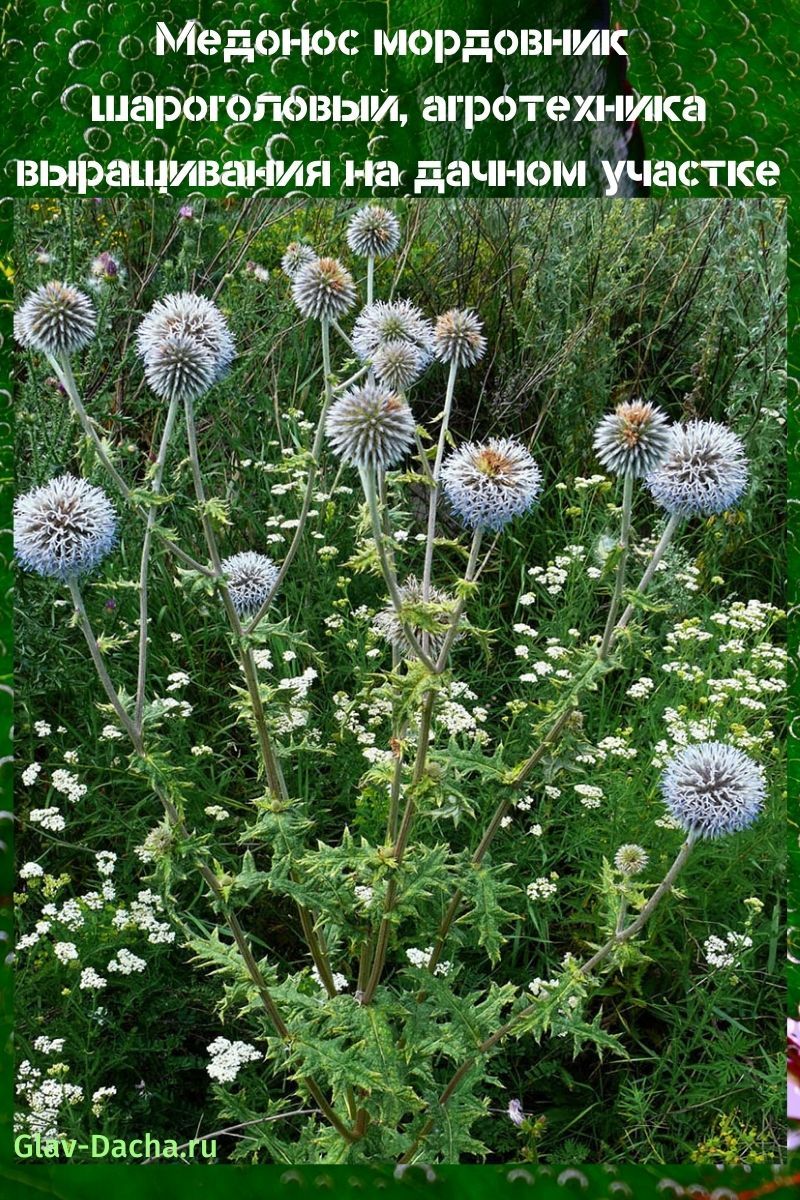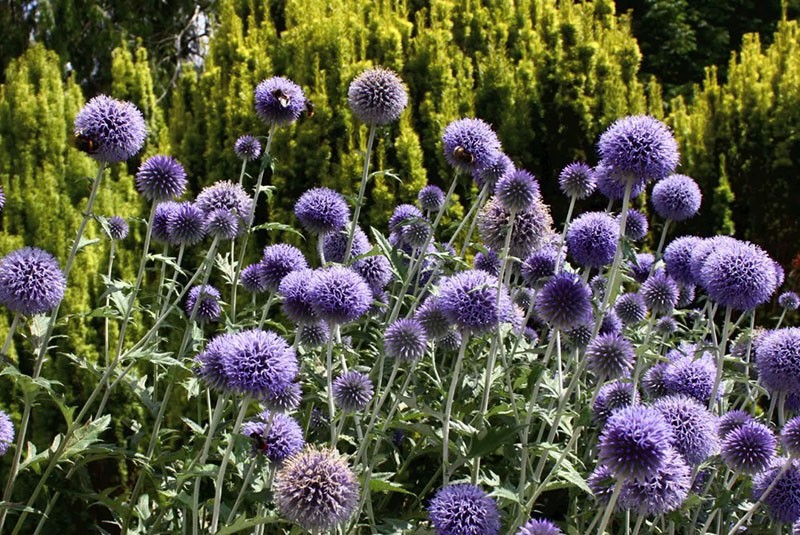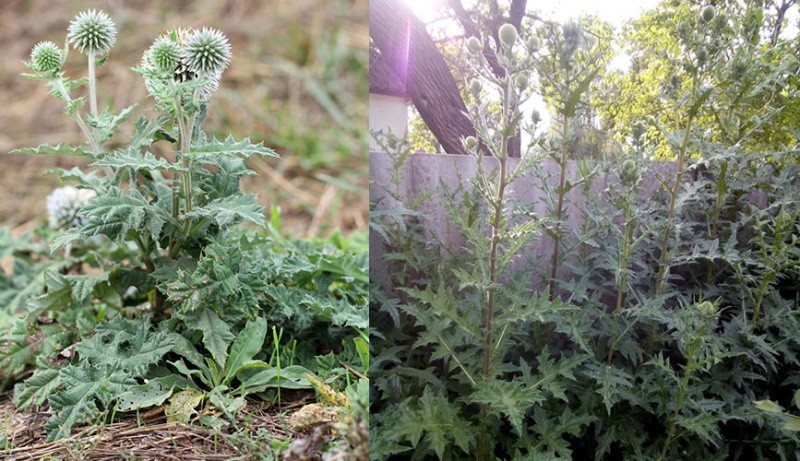Mordovnik ball-headed honey plant, agrotechnology of cultivation at their summer cottage
 In July, when the land is full of greenery, endless fields and meadows are covered with "precious" balls of blue and white. Amazing honey plant ball-headed mordovnik, whose agricultural technology is quite simple, can successfully "settle" in the summer cottage. And for beekeepers, the plant will turn out to be a real storehouse of precious substance. After all, worker bees are constantly circling over the pretty inflorescences. What is a ball-headed mordovia? What is his level of honey productivity? What is the agricultural technology of culture? Find out what the experts are saying.
In July, when the land is full of greenery, endless fields and meadows are covered with "precious" balls of blue and white. Amazing honey plant ball-headed mordovnik, whose agricultural technology is quite simple, can successfully "settle" in the summer cottage. And for beekeepers, the plant will turn out to be a real storehouse of precious substance. After all, worker bees are constantly circling over the pretty inflorescences. What is a ball-headed mordovia? What is his level of honey productivity? What is the agricultural technology of culture? Find out what the experts are saying.
External features of the plant

Ball-headed mordovia is considered a medicinal plant. Its components are included in the drug "Echinopsin".
During the season the plant grows up to 2 m in height. The main stem has an erect structure. Branching is observed only in the upper part of the culture. The surface of the shoots is strewn with miniature brown villi.
Slightly elongated leaf plates of the ball-headed muzzle have:
- pinnately dissected form;
- the edges are covered with small thorns;
- the front side is rough.
The front side of the foliage is colored deep green. The back is light gray. Plates are located along the entire stem, forming an elegant spiral. In the root area, they are large, and closer to the top, they are relatively small.
 During the flowering period, prickly balls form on the shoots. They consist of many small buds. Biologists count about 400 specimens. During the season, the culture can be decorated with about 35 inflorescences.
During the flowering period, prickly balls form on the shoots. They consist of many small buds. Biologists count about 400 specimens. During the season, the culture can be decorated with about 35 inflorescences.
They are often colored in tones.:
- blue;
- light blue;
- white.
 After repeated visits to insects, fruits appear on the culture. They are cylindrical achenes with a cupped tuft. It stores small planting material, ready to scatter along the ground.
After repeated visits to insects, fruits appear on the culture. They are cylindrical achenes with a cupped tuft. It stores small planting material, ready to scatter along the ground.
As a rule, the fruits of the muzzle are formed only the next year after planting the plant.
The value of culture for beekeepers
 Before we figure out how to sow the ball-headed mordovnik on our site, we will discuss its advantages as honey plant... Firstly, it perfectly tolerates sudden changes in temperature. Therefore, it is not afraid of spring frosts and summer heat. Secondly, for the entire season, the culture needs only one feeding.
Before we figure out how to sow the ball-headed mordovnik on our site, we will discuss its advantages as honey plant... Firstly, it perfectly tolerates sudden changes in temperature. Therefore, it is not afraid of spring frosts and summer heat. Secondly, for the entire season, the culture needs only one feeding.
 The honey productivity of the ball-headed mordovan has high rates. From an area of 1 hectare, beekeepers get about 1000 kg of sweet product. Even under unfavorable conditions, about 300 kg of honey is “squeezed out” from such a territory.
The honey productivity of the ball-headed mordovan has high rates. From an area of 1 hectare, beekeepers get about 1000 kg of sweet product. Even under unfavorable conditions, about 300 kg of honey is “squeezed out” from such a territory.
The sweet liquid has:
- transparent structure;
- light yellow tint;
- pleasant taste and aroma.
 It has been observed that the inflorescence of the scabbard produces abundant nectar. The substance is produced inside the buds and flows out through the corolla. There are times when the balls are completely filled with nectar. During the dry season, the amount of substance decreases dramatically. However, it is produced from early morning until sunset.
It has been observed that the inflorescence of the scabbard produces abundant nectar. The substance is produced inside the buds and flows out through the corolla. There are times when the balls are completely filled with nectar. During the dry season, the amount of substance decreases dramatically. However, it is produced from early morning until sunset.
On one site, the ball-headed honey plant can grow for about 10 years, which is very convenient for beekeepers.
Mordovnik ball-headed honey plant, agricultural technology of planting on fertile soil
 Some people think that a plant with graceful balls is a dangerous weed. Growing abundantly, it gradually displaces weaker crops. However, over time, it begins to degenerate if there are not enough nutrients in the soil.
Some people think that a plant with graceful balls is a dangerous weed. Growing abundantly, it gradually displaces weaker crops. However, over time, it begins to degenerate if there are not enough nutrients in the soil.
Therefore, beekeepers are guided by the basic principles of agricultural technology for growing the honey plant ball-headed mordovnik, which include a number of procedures:
- selection of fertile soil;
- search for a suitable site;
- period and method of sowing culture.
 Plant care consists of timely hydration and feeding. This approach has a beneficial effect on the germination, development and honey productivity of the culture.
Plant care consists of timely hydration and feeding. This approach has a beneficial effect on the germination, development and honey productivity of the culture.
The soil
 According to research by biologists, the ball-headed mordovan is considered an unpretentious plant. However, it develops much faster in drained soil.
According to research by biologists, the ball-headed mordovan is considered an unpretentious plant. However, it develops much faster in drained soil.
If necessary, nutrients are added to it:
- wood ash;
- dolomite flour;
- lime.
 Scarce sandy soil is fertilized with humus. Ultimately, the soil should be neutral. Before sowing, the site is thoroughly loosened and the surface is leveled.
Scarce sandy soil is fertilized with humus. Ultimately, the soil should be neutral. Before sowing, the site is thoroughly loosened and the surface is leveled.
Chernozem with a neutral acidity index is considered the ideal soil for the ball-headed mordovnik.
Appropriate place
 The ball-headed mordovia wonderfully takes root in open areas, where there is an abundance of sunlight. He is not afraid of through and gusty winds. It tolerates heat wonderfully and does not like excessive moisture. In shaded and waterlogged areas, the plant begins to hurt and eventually dies. The most suitable option is considered to be spacious fields on which corn or wheat used to grow.
The ball-headed mordovia wonderfully takes root in open areas, where there is an abundance of sunlight. He is not afraid of through and gusty winds. It tolerates heat wonderfully and does not like excessive moisture. In shaded and waterlogged areas, the plant begins to hurt and eventually dies. The most suitable option is considered to be spacious fields on which corn or wheat used to grow.
Preparation of planting material
 High-quality seeds of the ball-headed mordovia are collected or purchased in specialized stores. Raw materials are harvested from the second half of August to early October. During this period, the balls fully ripen. They are carefully cut from the bushes, since they crumble with a sharp movement. The collected material is stored until spring in a dry room at a temperature of 15 ° C.
High-quality seeds of the ball-headed mordovia are collected or purchased in specialized stores. Raw materials are harvested from the second half of August to early October. During this period, the balls fully ripen. They are carefully cut from the bushes, since they crumble with a sharp movement. The collected material is stored until spring in a dry room at a temperature of 15 ° C.
The size of high-quality specimens of the fruit is approximately 0.5 cm.
Phased work order
 The scheme for growing a cormorant from seeds, when to plant a crop and the rules for caring for it are the key to successful agricultural technology. The honey plant is sown in April or May in the spring or in September-October. In areas where there is little snow in winter, it is best to do business in early spring. Thanks to this, the plant will have time to take root during the warm season.
The scheme for growing a cormorant from seeds, when to plant a crop and the rules for caring for it are the key to successful agricultural technology. The honey plant is sown in April or May in the spring or in September-October. In areas where there is little snow in winter, it is best to do business in early spring. Thanks to this, the plant will have time to take root during the warm season.
When the ball-headed sculpin is sown on a large plot of land, the mechanical method of agricultural technology is most often used:
- plow the field;

- cultivated;
- sow the culture at a depth of 3 cm.
Immediately before starting work, the seeds are mixed with sawdust or fertilizer. When the seedlings appear and get stronger, a cultivator is passed through the aisles. As a result, all weeds die, and the soil is filled with oxygen.
 With the manual method of planting honey plants, they wait for the optimum temperature of the earth's surface (+ 14 ° C). The site is carefully dug up, removing dry grass and large roots. At a distance of 20 cm from each other, holes are made where seeds are sown. Close up the beds with a garden rake.
With the manual method of planting honey plants, they wait for the optimum temperature of the earth's surface (+ 14 ° C). The site is carefully dug up, removing dry grass and large roots. At a distance of 20 cm from each other, holes are made where seeds are sown. Close up the beds with a garden rake.
 Proper planting of the muzzle and the care of the honey plant play a key role in collecting sweet liquid. Although the culture is considered unpretentious, you still have to work hard. Young seedlings protect from weeds by regularly removing them from the garden. If necessary, dense plantings of the muzzle are thinned out. The next year after sowing, the aisles are thoroughly loosened to a depth of about 10 cm. At the end of the season, after the hedgehogs have ripened, the plants are shortened by 5 cm.
Proper planting of the muzzle and the care of the honey plant play a key role in collecting sweet liquid. Although the culture is considered unpretentious, you still have to work hard. Young seedlings protect from weeds by regularly removing them from the garden. If necessary, dense plantings of the muzzle are thinned out. The next year after sowing, the aisles are thoroughly loosened to a depth of about 10 cm. At the end of the season, after the hedgehogs have ripened, the plants are shortened by 5 cm.
Despite the fact that the culture tolerates dry periods wonderfully, in the first year it needs additional moisture.
 As you can see, the agrotechnology of growing the melliferous spherical head includes rather simple procedures. The soil should be neutral in acidity. Only open areas are suitable, where the through wind "walks". The crop is sown in early spring or mid-autumn. They are looked after according to agronomic rules. As a result, the plant will give beekeepers an abundance of precious sweet liquid.
As you can see, the agrotechnology of growing the melliferous spherical head includes rather simple procedures. The soil should be neutral in acidity. Only open areas are suitable, where the through wind "walks". The crop is sown in early spring or mid-autumn. They are looked after according to agronomic rules. As a result, the plant will give beekeepers an abundance of precious sweet liquid.